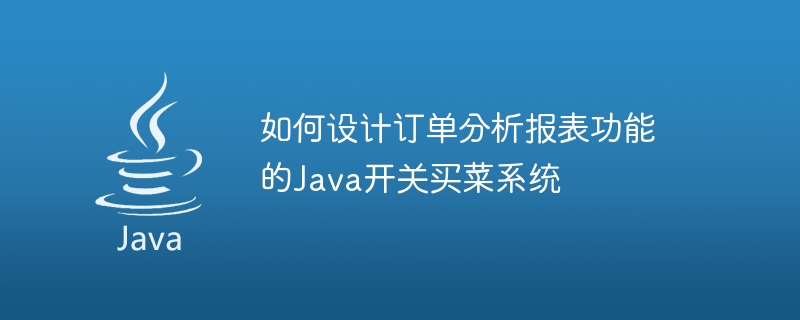
How to design a Java switch grocery shopping system with order analysis report function
1. Introduction
With the popularity of the Internet and the increasing attention to food safety issues, Purchasing fresh fruits and vegetables online has become a mainstream choice in modern urban life. In order to better meet the needs of users and provide better services, many online grocery shopping platforms have gradually introduced order analysis report functions. This article will introduce how to design a Java switch grocery shopping system with order analysis report function.
2. Demand analysis
- User needs:
(1) Users hope to intuitively understand their purchase records and consumption situations.
(2) Users need to query order statistical information, such as order quantity, total amount, etc.
(3) Users need to analyze their own consumption habits, such as favorite categories to purchase, purchase time periods, etc.
- System requirements:
(1) Provide order query function and support query by time range, order status and other conditions.
(2) Provide order statistics function, supporting statistics of order quantity, total amount, etc. by month, quarter, year and other dimensions.
(3) Provide order analysis function and support data analysis based on product category, purchase time and other dimensions.
3. System design
- Database design:
(1) Order table (order): records order-related information, including order number, user ID, placement Order time, order amount and other fields.
(2) Product table (product): records product-related information, including product ID, product name, product category and other fields.
(3) User table (user): records user-related information, including user ID, user name, mobile phone number and other fields.
(4) Order product association table (order_product): records the relationship between orders and products, including order ID, product ID and other fields.
- Business logic design:
(1) Order query function: According to the conditions entered by the user, query the order records that meet the conditions in the order table and display them to the user.
(2) Order statistics function: According to the statistical dimensions selected by the user, the corresponding summary calculation is performed in the order table, and the results are displayed to the user.
(3) Order analysis function: According to the analysis dimensions selected by the user, perform data association and calculation in the order table and product table, and display the results to the user.
- Interface design:
(1) Order query interface: Provides input boxes and query buttons for query conditions. After the user enters the query conditions, a table of query results is displayed.
(2) Order statistics interface: Provides selection boxes and statistics buttons for statistical dimensions. After the user selects the statistical dimension, a pie chart or bar chart of the statistical results is displayed.
(3) Order analysis interface: Provides selection boxes and analysis buttons for analysis dimensions. After the user selects the analysis dimensions, a table or chart of the analysis results is displayed.
4. System implementation
- Technical selection:
(1) Back-end technology: Java language Spring framework MyBatis framework.
(2) Front-end technology: HTML CSS JavaScript jQuery Bootstrap framework.
- Coding implementation:
(1) Back-end logic: Based on the business logic design in the requirements analysis, use Java language to write the back-end interface, and use the Spring framework to develop the control layer and service layer.
(2) Front-end interface: Based on the interface design in the demand analysis, use HTML and CSS to write the interface layout, use JavaScript and jQuery to handle user interaction, and use the Bootstrap framework to beautify the interface.
- Database implementation:
(1) Create the database table structure of order table (order), product table (product) and user table (user).
(2) Create the database table structure of the order product association table (order_product), and establish the corresponding foreign key relationship.
(3) Use the MyBatis framework to write SQL statements and corresponding data access interfaces to operate the database.
5. Testing and Optimization
- Unit testing: Unit testing of functions such as order query, order statistics and order analysis to ensure normal operation of the functions.
- System testing: Conduct functional and performance testing on the entire switch grocery shopping system to identify potential problems and optimize them.
- User feedback: Communicate with actual users, understand user needs and feedback, and further optimize the system.
6. Summary
Through the design of the order analysis report function of the Java switch grocery shopping system, users can more conveniently query order information, analyze consumption habits, and provide users with better shopping experience. At the same time, it provides a visual way to display order data, allowing users to understand their consumption more intuitively. Through system testing and optimization, the stability and performance of the system can be improved and the changes in user needs can be continuously met.
The above is the detailed content of How to design a Java switch grocery shopping system with order analysis report function. For more information, please follow other related articles on the PHP Chinese website!






